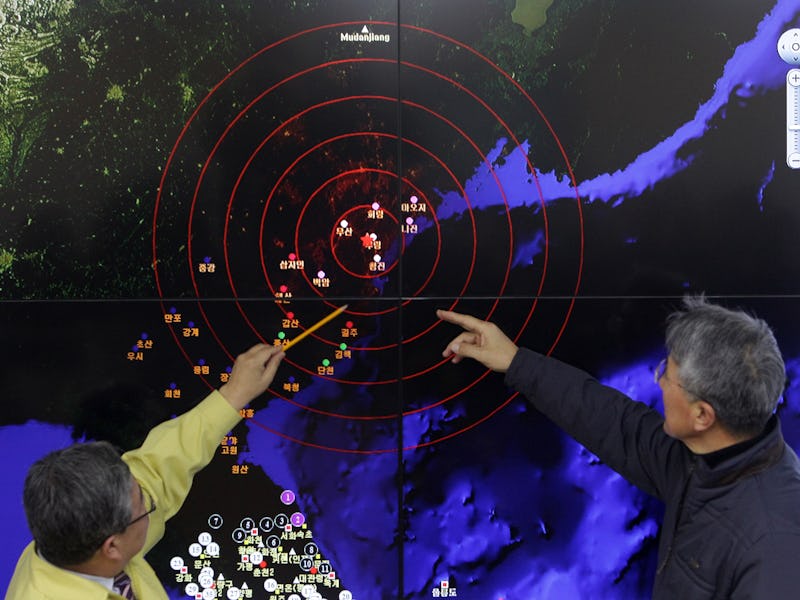North Korea Doesn't Have H-Bomb, but Latest Test Is Bad News
Bigger threat is miniaturizing the nukes and putting them on missiles.

North Korea’s nuclear weapons program makes no sense. That shouldn’t come as much of a shock, considering we’re talking about a top-secret program run by the world’s most isolated totalitarian regime and which is only officially covered by a state-run news media that basically exists in its own alternate reality. Each new North Korean nuclear test, the fifth and most recent of which was yesterday, is cause for a new round of analyzing, speculating, and — at least as far as the Korean Central News Agency is concerned — celebrating.
But it’s hard for an outside observer to figure out quite what the hell is going on. Case in point: North Korea claimed its fourth nuclear test in January was that of a hydrogen bomb. The yield of that particular blast was about six to nine kilotons, only about half that of the 15-kiloton blast of the atomic bomb the United States dropped on Hiroshima in 1945. Hydrogen bombs, though, have way, way bigger yields than that: The United States’s first test of an H-bomb in 1952 had a yield of 10.4 megatons, more than a thousand times the yield of North Korea’s supposed H-bomb blast.
The difference between these two types of bombs isn’t trivial. A standard nuclear weapon works through the fission, or splitting apart, of certain isotopes of certain elements. Weapons-grade uranium needs to be at least 90 percent comprised of uranium-235, which normally constitutes only 0.72 percent of all uranium. Unlike the more common uranium-238, uranium-235 is capable of creating the runaway chain reaction that causes the explosive release of energy. The process of getting the necessary concentration is known as uranium enrichment, which is one of many reasons it’s really damn hard to build a nuclear bomb.
It’s even more difficult to build a hydrogen bomb, which is partially why North Korea’s claims are disputed. Basically, a hydrogen bomb is a nuclear bomb with a couple extra stages: The initial fission bomb explosion emits gamma rays and X-rays, which heat up a nearby supply of what’s known as the fusion fuel, which is often composed of hydrogen isotopes — hence the name. The heating of that hydrogen-based fuel emits high-speed neutrons, which can then cause the explosive fission of normally safe materials. Depending on how many stages the bomb has, it could have an incredibly high destructive yield — the Soviet Union’s Tsar Bomba released 50 megatons, the biggest such explosion in history.
So given that science, how could North Korea have possibly detonated a hydrogen bomb that couldn’t even match the Hiroshima explosion? The obvious answer is that they didn’t, though experts haven’t ruled out the possibility that was what’s known as a boosted fission weapon, which is a much more primitive cousin of the hydrogen bomb that makes limited use of fusion reactions.
North Korea hasn’t claimed that its latest, approximately 10-kiloton explosion was that of a nuclear bomb. Instead, the state-run media has said this test has seen the country successfully miniaturize the weapons, meaning they have been scaled down so that they can be mounted on a missile and detonated. And that’s the bigger concern, really: While 10 kilotons isn’t that much relative to other nuclear weapons, it’s more than enough to do serious damage to anywhere North Korea can deliver the weapons to.
And that’s the next point on which we really don’t know what’s going on. North Korea’s missile program has never attained particularly impressive results, and certainly their long-range weapons capabilities appear non-existent at present, but last Monday’s tests of their Rodong missiles saw three of them travel about 300 miles, and experts suggest the actual range of such missiles could be quite a bit more than that: Seoul would definitely be within the target range, as might be Japan and American military bases in Guam.
Again, though, we’re working with precious little good information. We can say with some certainty that North Korea has made progress with both its nuclear weapons and with its missiles, and that progress appears to be coming at a quicker pace that first predicted. Whatever the case, the country doesn’t appear to pose any immediate threat to distant enemies like the United States, nor is it likely to unleash the kind of unimaginable destructive force the world feared from nuclear powers at the height of the Cold War. That could still mean North Korea is much closer than we thought to mounting a nuclear weapon onto a medium-range missile — but, as always, there’s a disquieting amount of guesswork we have to do here.